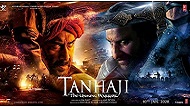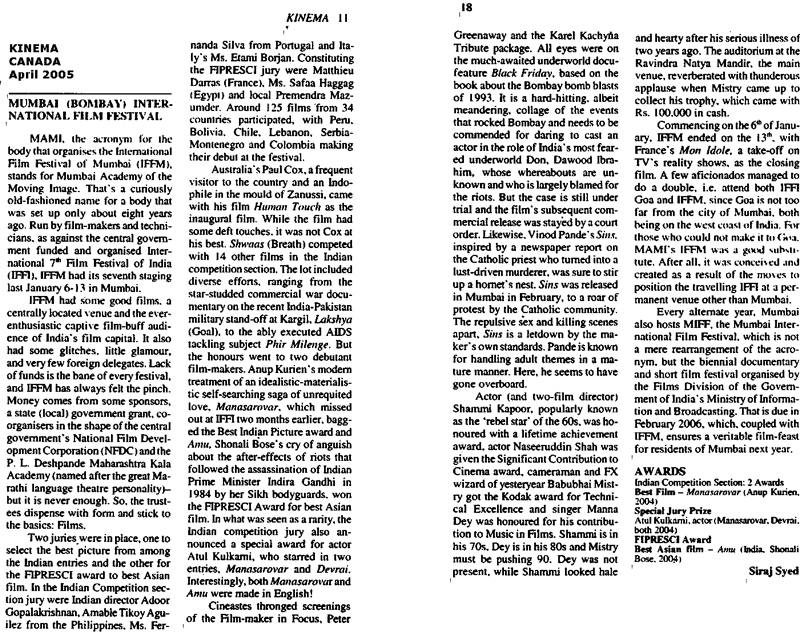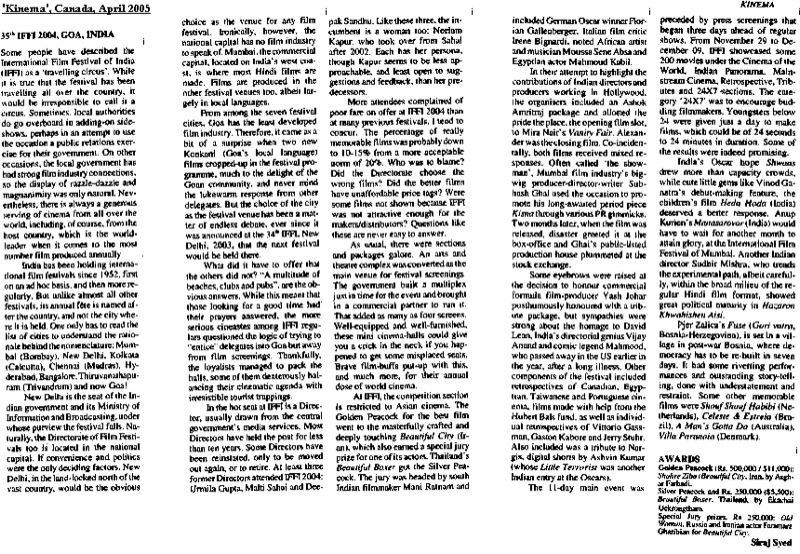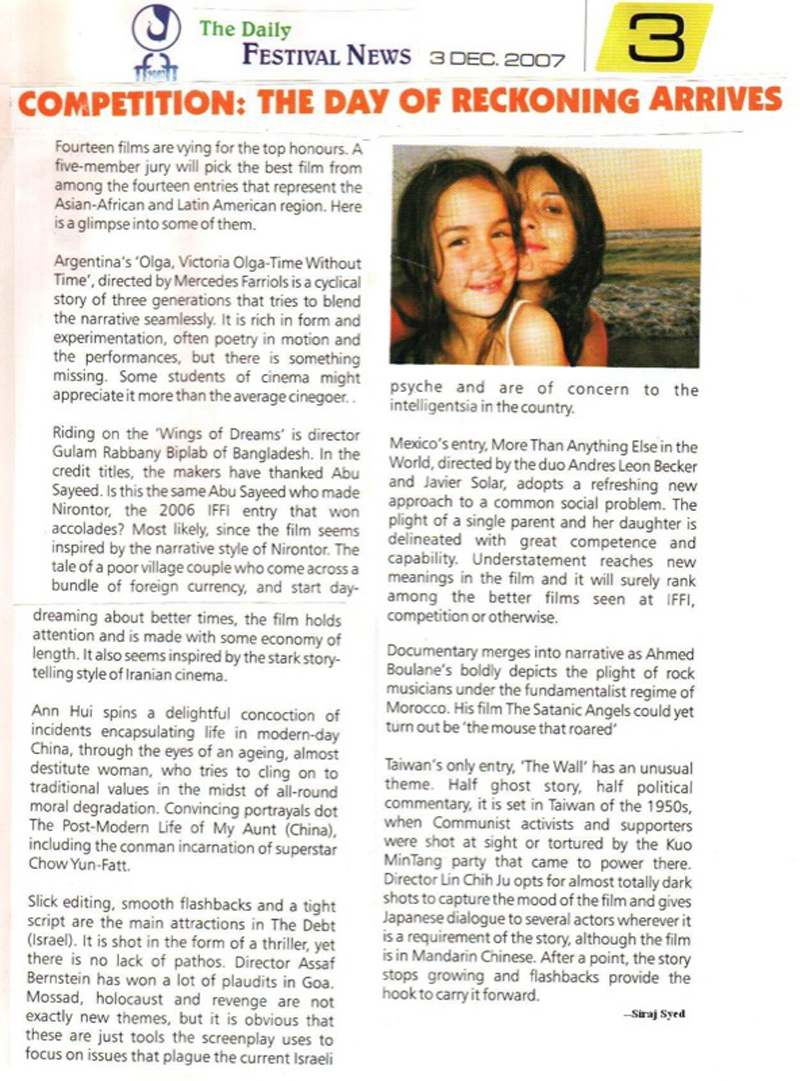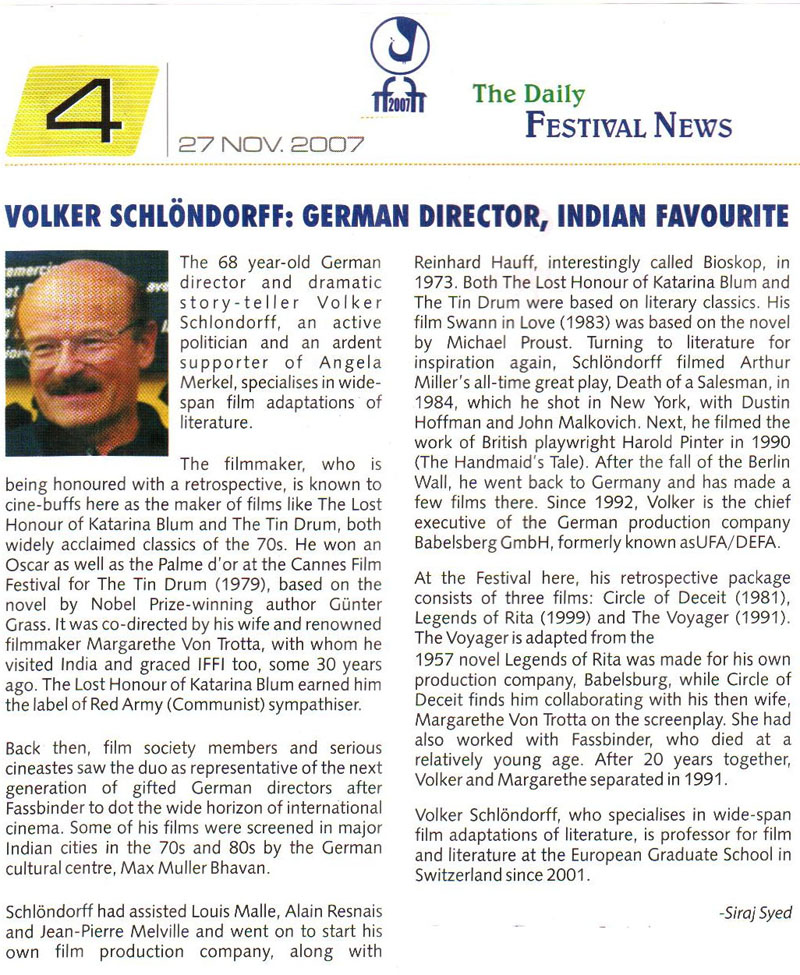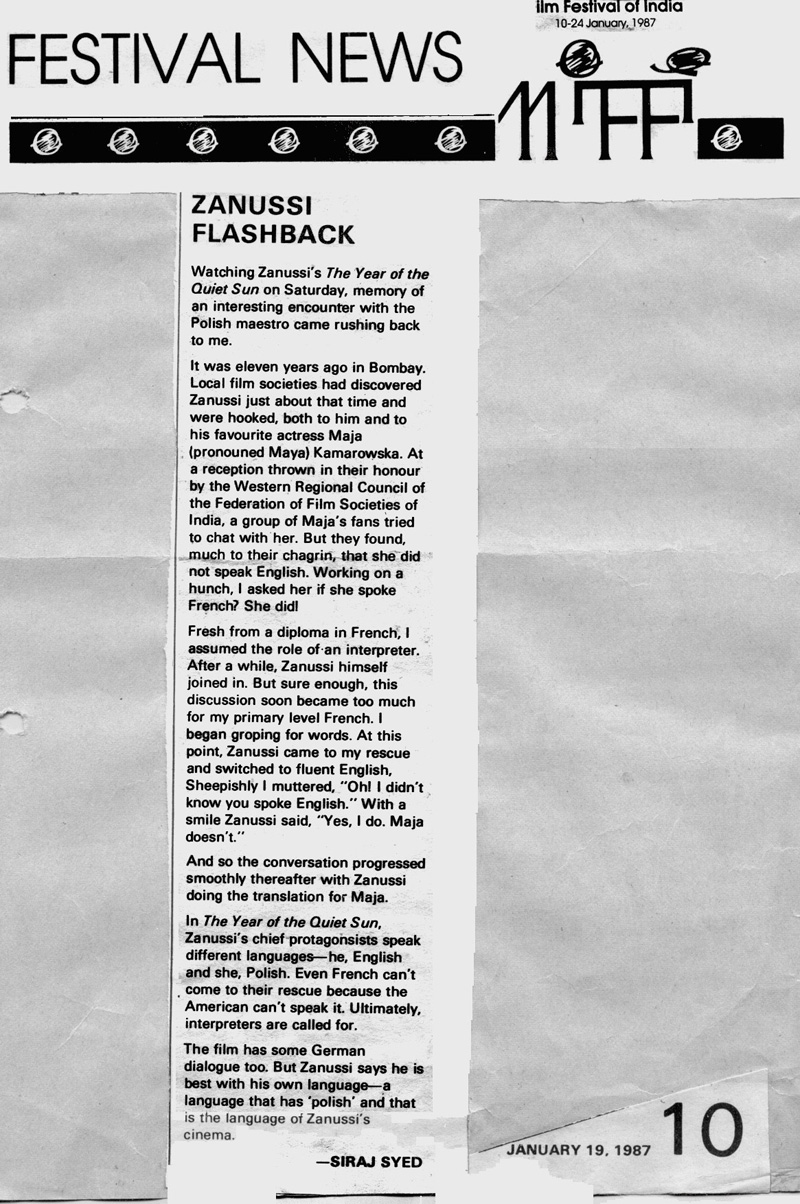|
|
||
|
Pro Tools
FILMFESTIVALS | 24/7 world wide coverageWelcome ! Enjoy the best of both worlds: Film & Festival News, exploring the best of the film festivals community. Launched in 1995, relentlessly connecting films to festivals, documenting and promoting festivals worldwide. Working on an upgrade soon. For collaboration, editorial contributions, or publicity, please send us an email here. User login |
Tanhaji-The Unsung Warrior, Review: Leap of faith
Tanhaji-The Unsung Warrior, Review: Leap of faith High on spectacle and CGI, Tanhaji: The Unsung Warrior is a 3D extravaganza that taps nationalistic fervour, digging into history, and re-tracing a glorious chapter from the life and times of Chhatrapati Shivaji Maharaj. Patriotism is not a recent ideal, and the 17th century is fairly recent for a country that was home to the Indus Valley Civilisation. Generous liberties are taken with the story, as is the norm in biopics, either to fill in the blanks, or to create cinematic impact. And impact it does. Tanhaji’s father, a brave warrior, loses an arm in battle, and as he dies, he passes on his kadaa (metallic bangle/bracelet) to his young son. Tanhaji grows up to become a great warrior himself. The manner in which he takes on an enemy army from atop a mountain, using ropes to slide down on them from the top, would do any general proud. Soon he becomes one of the four commanders in Chhatrapati Shivaji Maharaj’s army. One of the other three was a Muslim, the voice-over (Sanjay Mishra, bad choice) tells us. It is the late 17th century. The Mughal Emperor Aurangzeb has declared the strategic hill fortress Kondhana as the Mughal base of Southern India, from which he plans to expand the Mughal Empire into South (Dakshin or Deccan) India, the conquest of which has proved to be hitherto elusive. He sends UdayBhan Singh Rathod, a Rajput, from the North, to look after the fort. UdayBhan proved himself to be valorous and strong as he took on horse-back soldiers who attacked him after a game of chess, using humans as pawns, between Aurangzeb and King Pahlavi of Iran. UdayBhan was one of the losing ‘pawns’. Shivaji has escaped from Aurangzeb’s custody in Agra, and has ceded 23 of his forts in a treaty. He is now back in his kingdom, which lies in and around present-day Maharashtra. When he hears of the impending arrival of UdayBhan, he orders Tanhaji to capture Kondhana (present day Sinhagad) at any cost. Instead of waiting for UdayBhan to reach Kondhana, Tanhaji decides to attack him en route, where he would be more vulnerable. Accordingly, Tanhaji lays a trap. When he sees a bunch of soldiers approaching, with what looks like a huge cannon, he and his soldiers charge at them, killing quite a few. But to their utter horror, they discover that the ‘Mughal soldiers’ are in fact their own brethren, gagged and bound, and UdayBhan has proceeded by the river route. The cannon, too, is a dummy, made from a coconut tree. After hoodwinking Tanhaji Malusare, UdayBhan reaches Kondhana, bringing with him the huge cannon, called the naagin (snake). Now, Tanhaji must attack the lion in his den, which is practically impregnable, before UdayBhan unleashes his naagin and destroys other forts in the region. Although his son, Raiba, is to be married in a few days, he leaves him and his loving wife Savitribai behind, to lead an assault on Kondhana. The battle is known as the Battle of Sinhagad (Shivaji renamed Kondhana as Sinhagad, in honour of his Sinha ‘lion’, Tanhaji). On the writing desk, the movie has the man who penned Devdas, Black, Saawariya, Bajirao Mastani and Padmaavat, Prakash Kapadia. Sharing credit is director Om Raut, who lived with this project from 2006 and worked on it seriously for three years, 2015-18. Controversy dogs Tanhaji from the title itself. A descendent of Tanhaji, Prasad Malusare, held a press conference in Pune on December 14, 2019, and said that “We have strong objection on the name of the movie Tanhaji - The Unsung Warrior, as we believe that every person from Maharashtra knows about Tanaji and his bravery. There is a lesson on him in our textbooks, then why it is called as unsung warrior?” Why indeed? Well, he needs to be glorified much more than the share of glory he has been given. “There is one scene shown in the movie trailer that Tanaji is tied up in iron ropes and talking to Mughal Sardar UdayBhan Rathod, but in history there is no evidence of such incidence.” Obviously, Prasad Malusare is peeved at cinematic licence, and as an heir to Tanhaji’s heritage, he has a right to feel outraged, just as Om Raut has a right to fictionalise and dramatise events of 360 years ago. The Hindu, in its edition dated November 23, 2019, reports that an outfit called Sambhaji Brigade, has raised objections to the scene showing a bearded person (allegedly the form of Shivaji’s spiritual guru, Samarth Ramdas) hurling a stick at Chhatrapati Shivaji. “We wonder what the objective of the film-makers was in depicting such a scene, which is downright apocryphal. We condemn Ajay Devgn for such phoney depictions, and we request them to delete these scenes,” Mr. Shinde said. Well, I was not privy to any such scene. What I saw on screen yesterday was Tanhaji, made-up, as and pretending to be, a spiritual guru, in order to prevail upon Shivaji to give him permission to go on his mission. Whether such impersonation is in good taste or not is another matter. As a critic, I found the scene somewhat childish, and, yes, in poor taste. The outfit has also taken strong objection to the scene in which actor Kajol, who portrays Tanhaji’s wife, Savitribai, is heard saying that Chhatrapati Shivaji’s sword is meant to safeguard a woman’s veil and a Brahmin’s sacred thread. “King Shivaji safeguarded all castes and communities and not only Brahmins. This seems an attempt on part of the film-makers to erase Shivaji’s inclusive and secular image. We urge the filmmakers to remove these scenes,” Mr. Shinde of the Brigade said. Well, in the released version, Savitri is not heard saying anything like this, so, if indeed there was a piece of dialogue to this effect, it has been removed. On December 12, 2019, the Akhil Bhartiya Kshatriya Koli Rajput Sangh filed a petition before the Delhi High Court, claiming that Om Raut, the director of Tanhaji: The Unsung Warrior, has concealed the true lineage of the great warrior Tanaji Malusare in the movie. I don’t know what happened to the petition, but I did notice a couple of words muted, and, in the context, they could have been referring to religion or caste. Perhaps the muting was in deference to the Sangh, which might now be assuaged. Iran was ruled by the Safavids during 1501-1736, and though I am a descendent of the Safavids from my mother’s side, I have no intention of filing any petition against the inclusion of a game of human chess between Aurangzeb and ‘King Pahlavi’ of Iran, at a time when the Pahlavi was an unknown entity. King Reza Shah Pahlavi ruled Iran only in the 20th century. If the name caught the fancy of M/s Kapadia and Raut, so be it. Taking liberties is all very well, but a screenplay must proceed in a logical and self-explanatory manner. Gaffes or unexplained events are the bane of any film, and bigger the film, the more they come into focus. You read above that UdayBhan suddenly changes his route and travels by the river. There is nothing to suggest that he was carrying the requisite number of boats, including a giant one that could mount the naagin on it. Again, UdayBhan Singh is shown to be hopelessly in love with a Rajput woman, Kamla Devi, whom he kidnaps from the funeral pyre of her husband and takes along wherever he goes. She steadfastly refuses to give in to his advances. He, for his part, does not want to force himself on her, and waits for her to be won over. This is completely out of character. That he employs her brother at a senior position in his army is even more out of character, for he can be betrayed by the duo, as he does. UdayBhan has Tanhaji on his feet, with an arm chopped off and an arrow wound in his back. Yet, for reasons unknown, instead of killing him with one blow, UdayBhan merely keeps the wrong end of his sword at Tanhaji’s neck for eternity, ensuring his own demise. Instead of getting down to business and blasting away at neighbouring forts, UdayBhan merely bides time, an extended period of time, doing pretty much nothing. A shrewd war-monger, UdayBhan would have checked the fort for secret passages and concealed doors the first thing after he came and settled there. He doesn’t, and pays for it dearly. This is the second film of Om Raut (aged 33; Lokmanya: Ek Yug Purush), and he has shown a penchant for gory violence and cliff-hangers. Body parts getting severed is the norm. With most proceedings in grey, lances and arrows leap at you from the screen, making you blink in amazement. Raut’s UdayBhan is an adversary who can match the hero, and, if only history had allowed him, he would have prevailed over his nemesis. However, no film would have been made on this battle, in that case. A sense of humour and a swagger are among his other traits. Besides bravura and shrewdness, Tanhaji also has the gift of the gab, and persuades both Shivaji and Savitri to think on his lines. An entire scene to herself, post climax, brilliantly lit, gives heart-tugging sentimentality to Savitri’s character. There is an overdose of saffron (bhagva), the colour that best symbolises the Hindu faith, and a surfeit of “Har Har Mahadev,” the Hindu slogan and battle cry. Both elements will find favour with the present political dispensation in the country and ultra-right fundamentalist ideology. Having established the milieu, such a slant is only a natural stance. Ajay Devgn as Tanhaji Malusare, his 100th part at the age of 50 (looks much younger), is a powerhouse performance, in a home production. Towards the climax, he garners thunderous applause and evokes patriotic cries, even as his horse leaps over the cannon, in a metaphorical leap of faith. Kajol as Savitri and Ajay (real-life couple) make a winsome pair. Kajol still has that wide-eyed smile, with a twinkle in her pupils that is nothing, if not captivating. Saif Ali Khan as UdayBhan Singh Rathod is the surprise packet here. Modelled on Alauddin Khilji (Ranveer Singh) of Padmaavat, he is as much a scene-stealer here as he was essaying Langda Tyagi in Omkara, where his co-star was again Ajay. In fact, that outing must have been the greatest influence behind his casting. Sharad Kelkar as Chhatrapati Shivaji Maharaj is stately without being quite the Shivaji we were expecting. Luke Kenny is cast as Aurangzeb, an odd bit of casting, and not very convincing either. Padmavati Rao, playing Rajmata Jijabai (Shivaji’s mother), is as impressive as she was when she first hit the Mumbai stage. Ajinkya Deo plays Pisal, the betrayer, with that villainous edge. Neha Sharma as Kamla Devi, and Vipul Kumar Gupta as her brother Jagat Singh, provide adequate support. Cinematography by Keiko Nakahara is of a high calibre and editing by Dharmendra Sharma is brutally slick, apparently pruning and/excising several scenes, judging by the cutting points. Overall, production values, technology, sentiments and performances stand the film in good stead. There are many loopholes and pitfalls, but, like the rope-trick and the horse-leap, Tanhaji: The Unsung Warrior, takes the aerial route to make its escape. Rating: *** Trailer: https://www.youtube.com/watch?v=cffAGIYTEHU 10.01.2020 | Siraj Syed's blog Cat. : Ajay Devgn Ajinkya Deo Jijabai Kajol Kondhana Luke Kenny Neha Sharma Om Raut Padmavati Rao Prakash Kapadia Saif Ali Khan Sharad Kelkar Shivaji Sinhagad Vipul Kumar Gupta Independent FILM
|
LinksThe Bulletin Board > The Bulletin Board Blog Following News Interview with IFTA Chairman (AFM)
Interview with Cannes Marche du Film Director
Filmfestivals.com dailies live coverage from > Live from India
Useful links for the indies: > Big files transfer
+ SUBSCRIBE to the weekly Newsletter Deals+ Special offers and discounts from filmfestivals.com Selected fun offers
> Bonus Casino
User imagesAbout Siraj Syed Syed Siraj Syed Siraj (Siraj Associates) Siraj Syed is a film-critic since 1970 and a Former President of the Freelance Film Journalists' Combine of India.He is the India Correspondent of FilmFestivals.com and a member of FIPRESCI, the international Federation of Film Critics, Munich, GermanySiraj Syed has contributed over 1,015 articles on cinema, international film festivals, conventions, exhibitions, etc., most recently, at IFFI (Goa), MIFF (Mumbai), MFF/MAMI (Mumbai) and CommunicAsia (Singapore). He often edits film festival daily bulletins.He is also an actor and a dubbing artiste. Further, he has been teaching media, acting and dubbing at over 30 institutes in India and Singapore, since 1984.View my profile Send me a message The EditorUser contributions |

















